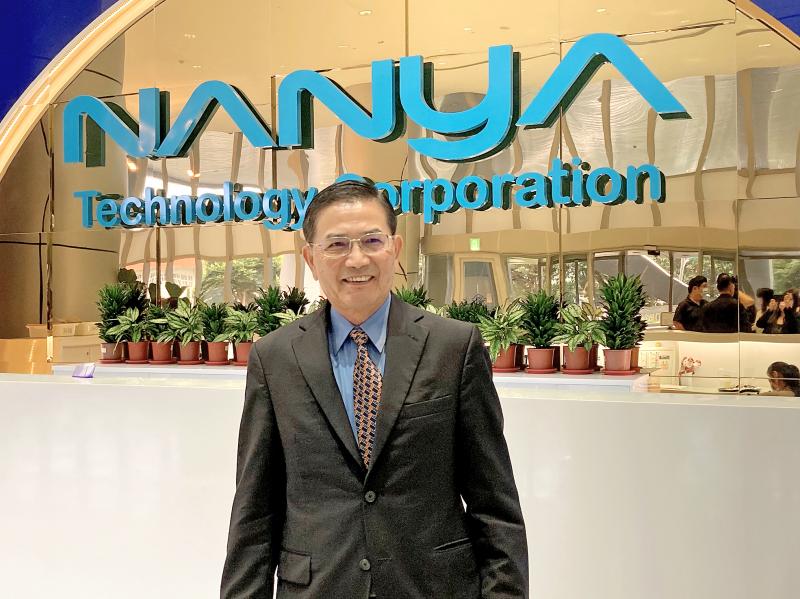DRAM chipmaker Nanya Technology Corp (南亞科技) yesterday said it would hold on to 30 percent of its overall capital expenditures earmarked for this year to use next year, given slackening market demand.
That would reduce the company’s spending on new facilities and equipment to about NT$10.7 billion (US$370.13 million) this year, instead of the NT$15.7 billion budgeted.
The move is in line with its bigger competitors’ conservative outlook about the memory industry.

Photo: Lisa Wang, Taipei Times
“That is primarily because of the overall [changes] in market situation,” Nanya Technology president Lee Pei-ing (李培瑛) told a media briefing at the company’s headquarters in New Taipei City’s Taishan District (泰山). “We have a conservative view of capital expenditures.”
However, the changes in capital spending would not affect its technological migration, Lee said.
Nanya Technology is on schedule to start pilot production of its 1A process technology this quarter, paving the way for revenue contribution from the technology at the end of next year, he said.
The chipmaker also expects the supply-demand situation to stabilize in the first half of next year, given limited supply growth and low inventories.
That would lead to a rebound in memorychip prices, it said.
As for the impact of Washington’s export restrictions on Huawei Technologies Co (華為), Lee said it should be rather short-lived given the Nanya’s broad customer portfolios and product lineup.
The firm supplies chips to more than 700 customers, he said.
The impact could last for two quarters, Lee said, echoing Micron Technology Inc’s recent comments on the loss of Huawei orders.
Other Chinese mobile phone makers would fill the void left by Huawei, he said.
Nanya Technology stopped shipping memory chips to Huawei as of Sept. 15 as the US restrictions took effect, and is waiting for the US government to approve it resuming shipments to Huawei.
As speculation swirled that Chinese memorychip maker Yangtze Memory Technology Corp (長江存儲) could be Washington’s next target, Lee said that such a move would not have much of an effect on his firm, given the Chinese company’s small market share.
Nanya also reported a contraction of 50 percent last quarter in net profit, to NT$1.61 billion, compared with NT$3.22 billion the previous quarter, and the lowest since the fourth quarter of last year.
Revenue was NT$15.32 billion, while its gross margin dipped to 25.9 percent last quarter from 30.6 percent in the second quarter.
The company attributed the weakness to a low single-digit percentage decline in average selling prices and shipments last quarter, as well as unfavorable foreign exchange rate and higher tax payments.
Nanya Technology expects sales of DRAM chips used in servers to drop mildly on a quarterly basis this quarter, while DRAM chips used in other applications such as laptops and mobile phones are forecast to pick up.

CHIP RACE: Three years of overbroad export controls drove foreign competitors to pursue their own AI chips, and ‘cost US taxpayers billions of dollars,’ Nvidia said China has figured out the US strategy for allowing it to buy Nvidia Corp’s H200s and is rejecting the artificial intelligence (AI) chip in favor of domestically developed semiconductors, White House AI adviser David Sacks said, citing news reports. US President Donald Trump on Monday said that he would allow shipments of Nvidia’s H200 chips to China, part of an administration effort backed by Sacks to challenge Chinese tech champions such as Huawei Technologies Co (華為) by bringing US competition to their home market. On Friday, Sacks signaled that he was uncertain about whether that approach would work. “They’re rejecting our chips,” Sacks

Taiwan’s long-term economic competitiveness will hinge not only on national champions like Taiwan Semiconductor Manufacturing Co. (TSMC, 台積電) but also on the widespread adoption of artificial intelligence (AI) and other emerging technologies, a US-based scholar has said. At a lecture in Taipei on Tuesday, Jeffrey Ding, assistant professor of political science at the George Washington University and author of "Technology and the Rise of Great Powers," argued that historical experience shows that general-purpose technologies (GPTs) — such as electricity, computers and now AI — shape long-term economic advantages through their diffusion across the broader economy. "What really matters is not who pioneers

In a high-security Shenzhen laboratory, Chinese scientists have built what Washington has spent years trying to prevent: a prototype of a machine capable of producing the cutting-edge semiconductor chips that power artificial intelligence (AI), smartphones and weapons central to Western military dominance, Reuters has learned. Completed early this year and undergoing testing, the prototype fills nearly an entire factory floor. It was built by a team of former engineers from Dutch semiconductor giant ASML who reverse-engineered the company’s extreme ultraviolet lithography (EUV) machines, according to two people with knowledge of the project. EUV machines sit at the heart of a technological Cold

TAIWAN VALUE CHAIN: Foxtron is to fully own Luxgen following the transaction and it plans to launch a new electric model, the Foxtron Bria, in Taiwan next year Yulon Motor Co (裕隆汽車) yesterday said that its board of directors approved the disposal of its electric vehicle (EV) unit, Luxgen Motor Co (納智捷汽車), to Foxtron Vehicle Technologies Co (鴻華先進) for NT$787.6 million (US$24.98 million). Foxtron, a half-half joint venture between Yulon affiliate Hua-Chuang Automobile Information Technical Center Co (華創車電) and Hon Hai Precision Industry Co (鴻海精密), expects to wrap up the deal in the first quarter of next year. Foxtron would fully own Luxgen following the transaction, including five car distributing companies, outlets and all employees. The deal is subject to the approval of the Fair Trade Commission, Foxtron said. “Foxtron will be